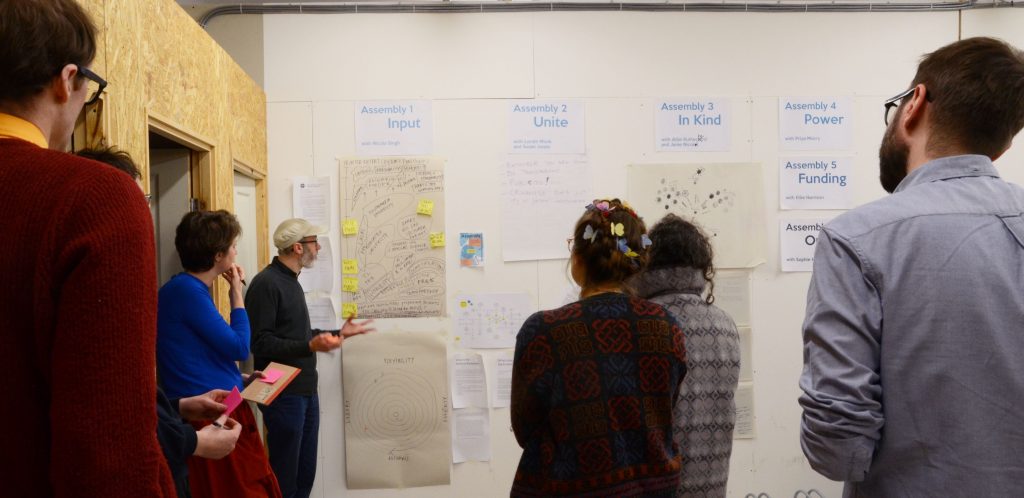In early November, 25 researchers from Europe and North America met in New York to talk about the themes and tensions in the worldwide development of the gig economy and more broadly about the future of workforces.
The workshop was coordinated as part of the Computer-Supported Collaborative Work conference (CSCW’18) in association with the Not-Equal Network+.
Ann Light, Professor of Design & Creative Technology at the University of Sussex shares her thoughts that came from the discussions.
What’s new about the digital economy?
Networks have introduced platforms that stretch across borders, making them hard to regulate and introducing a global market for many types of work. The platforms allow considerable expansion and control across networks using a single instantiation of code, without a large staff base, and the data can be collected and aggregated, recording and monitoring the workers’ every action.
In the short term, this is increasing performance regulation and pressure on workers. In the longer term, in combination with advances in AI, this can be used to train AI to perform the work. This type of automation could have big impacts on the logistics and transport industries, such as delivery by drones rather than people.
Work platforms have also created a new type of workplace. These workplaces no longer have: a location, colleagues or protections, but instead are the source and control of the work. It fills this role by demanding the worker’s focus.
The boss as an algorithm
There is an increasing sense that, in platform industries, people are now working for a system in which no person has the final say. Opportunities, incentives and competition models are programmed in and then optimized for a particular set of circumstances. While this creates an environment where every worker is treated to a level playing field, it takes no account of differences, needs or other discretionary components.
Overall, the drive for efficiency and productivity tends to level the field down and optimize profit, not working conditions. In fact, talk of the algorithm refers to a complex system that is actually an assembly of algorithms that produce intersections of behaviour. Engineers do not sit together and co-create it and no one has the whole picture anymore. The assembly has, as an aggregate, a life of its own and exists outside even the limits of the company.
Mechanisms to seduce, retain and exploit workers are standard components of many platforms. Some of these encourage productivity through gamification. Elsewhere, workers keep their independence by playing off multiple employers or working with multiple phones/apps to keep track of different perspectives, gaming the system, yet hooking themselves in at the same time.
The challenges for the platform economy
A major challenge for these platforms is the regulation across different countries. New global companies need to be handled with a more joined-up approach to monitoring and regulation, but there is no organization with that oversight.
Digital tools can help with the overview, but it takes a political will to introduce structures to impose fairer systems. In the meantime, there is a desire to tax platforms in the country of use, not the country of registration, to compensate for loss of tax revenue, but no power to do so. And there is an ongoing loss of protections for workers as their status changes from employee to self-employed.
The new casualization in industrialized nations is being marketed as flexibility as to when and how much you work. This keeps people on terms of self-employment where there would once have been employee protection. And while the rhetoric is of supplementing your income with a few ‘gigs’, if you need to make a lot of money, you lose control.
The very idea of flexibility is mediated by the need to respond to the market. The platforms are tuned so that consumers, not suppliers, are satisfied and adjust supply according to demand. Workers may be opened to new, broader or more focused markets by platforms, or they may merely be exposed to more competition. This precarity was never evenly balanced world-wide; it is only new to some contexts.
Where there were no jobs or only very poorly paid day/piecework labour, flexible working across platforms enables new pockets of viability. For most service provision, remuneration varies with the local market.
But in areas where there is a global market, the benefit to some parts of the world is at a cost to workers in the same sector in parts where the cost of living and salaries are generally higher. Even in these contexts, work is not always flexible: it may mean working in the middle of the night to align with when requesters in other parts of the world are setting tasks.
What can be done to alleviate tensions around the platform economy?
Transparency, especially as it is enacted, is not enough; it needs to be meaningful. If people’s value was more visible in the process it might result in better remuneration. If implications (as well as uses) were more visible, this might reduce negative outcomes.
Many initiatives produce charades of transparency, not actual visibility of processes or what happens to data. Further, transparency rarely works in a way that enables individuals or groups to affect outcomes.
Coordination is possible, but action is mostly coming from those challenged by the new platforms, not gig economy workers, for example the taxi protests at Uber introductions. The atomization of work through self-employment and deliberate strategies by platforms to stop colleagues identifying each other and organizing makes the future of industrial action uncertain.
However, new unions have been appearing, e.g. Independent Workers Union of Great Britain (IWGB), which “represents mainly low paid migrant workers, such as outsourced cleaners and security guards, workers in the so-called gig economy, such as bicycle couriers and Uber drivers, and foster care workers.”
The IWGB specializes in representing sections of the workforce which have traditionally been non-unionised and under-represented. There are also friendship/support groups working less formally and other mechanisms, such as recommender systems for platforms (such as Turkopticon’s worker-reviewed Human Intelligence Tasks for Amazon Mechanical Turk).
All these topics arose in discussions at the workshop. Of course, other discussions of the future of work have informed what we addressed. That said, it was great to see such a strong interest in the social justice aspects, rather than regarding the new platforms principally as disruptive business mechanisms or new sources of productivity.



